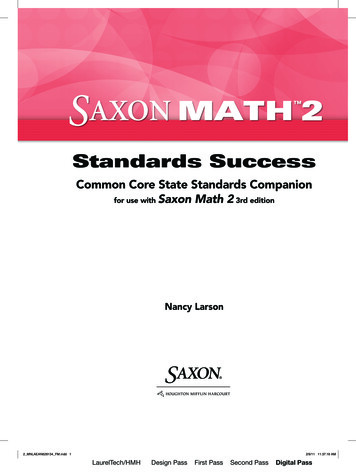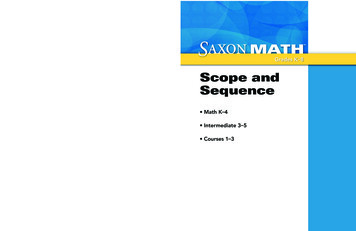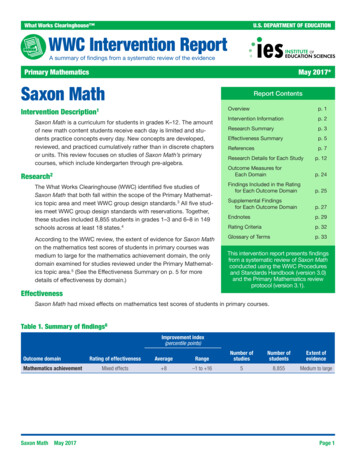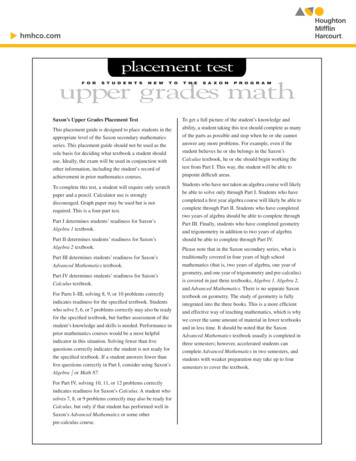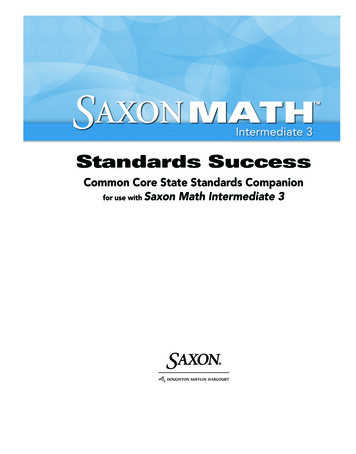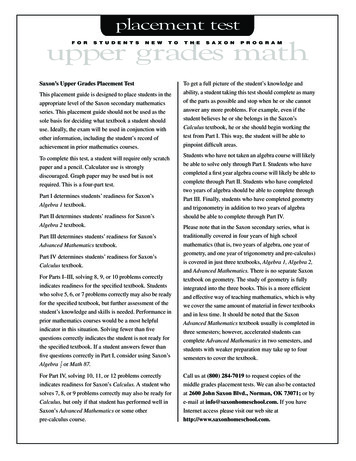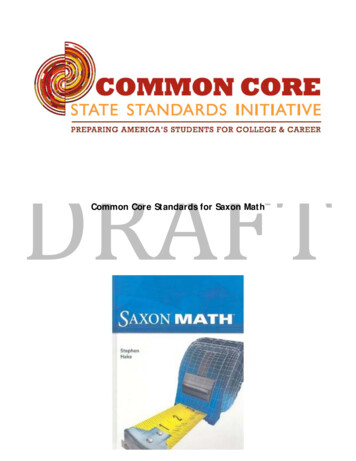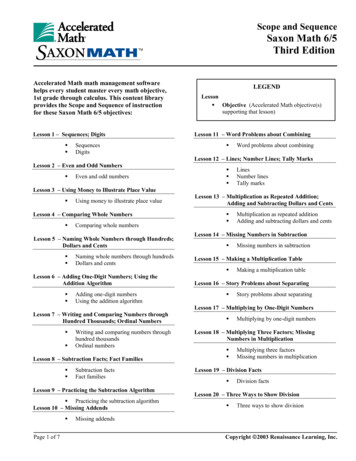
Transcription
Scope and SequenceSaxon Math 6/5Third EditionAccelerated Math math management softwarehelps every student master every math objective,1st grade through calculus. This content libraryprovides the Scope and Sequence of instructionfor these Saxon Math 6/5 objectives:Lesson 1 – Sequences; DigitsSequencesDigitsLEGENDLessonObjective (Accelerated Math objective(s)supporting that lesson)Lesson 11 – Word Problems about CombiningWord problems about combiningLesson 12 – Lines; Number Lines; Tally MarksLesson 2 – Even and Odd NumbersEven and odd numbersLinesNumber linesTally marksLesson 3 – Using Money to Illustrate Place ValueUsing money to illustrate place valueLesson 4 – Comparing Whole NumbersComparing whole numbersLesson 5 – Naming Whole Numbers through Hundreds;Dollars and CentsNaming whole numbers through hundredsDollars and centsLesson 13 – Multiplication as Repeated Addition;Adding and Subtracting Dollars and CentsMultiplication as repeated additionAdding and subtracting dollars and centsLesson 14 – Missing Numbers in SubtractionMissing numbers in subtractionLesson 15 – Making a Multiplication TableMaking a multiplication tableLesson 6 – Adding One-Digit Numbers; Using theAddition AlgorithmAdding one-digit numbersUsing the addition algorithmLesson 16 – Story Problems about SeparatingStory problems about separatingLesson 17 – Multiplying by One-Digit NumbersLesson 7 – Writing and Comparing Numbers throughHundred Thousands; Ordinal NumbersWriting and comparing numbers throughhundred thousandsOrdinal numbersLesson 8 – Subtraction Facts; Fact FamiliesSubtraction factsFact familiesLesson 9 – Practicing the Subtraction AlgorithmPracticing the subtraction algorithmLesson 10 – Missing AddendsMultiplying by one-digit numbersLesson 18 – Multiplying Three Factors; MissingNumbers in MultiplicationMultiplying three factorsMissing numbers in multiplicationLesson 19 – Division FactsDivision factsLesson 20 – Three Ways to Show DivisionThree ways to show divisionMissing addendsPage 1 of 7Copyright 2003 Renaissance Learning, Inc.
Scope and SequenceSaxon Math 6/5Third EditionLesson 21 – Problems about Equal GroupsProblems about equal groupsLesson 22 – One-Digit Division with a Remainder;Divisibility by 2, 5, and 10One-digit division with a remainderDivisibility by 2, 5, and 10Lesson 23 – Recognizing HalvesRecognizing halvesLesson 24 – Parentheses; Associative PropertyParenthesesAssociative propertyLesson 25 – Listing the Factors of Whole NumbersListing the factors of whole numbersLesson 34 – Division with Zeros in the QuotientDivision with zeros in the quotientLesson 35 – Problems about Comparing; Problemsabout Elapsed TimeProblems about comparingProblems about elapsed timeLesson 36 – Classifying TrianglesClassifying trianglesLesson 37 – Drawing Pictures of FractionsDrawing pictures of fractionsLesson 38 – Fractions and Mixed Numbers on aNumber LineFractions and mixed numbers on anumber lineLesson 26 – Division AlgorithmDivision algorithmLesson 39 – Comparing Fractions by Drawing PicturesComparing fractions by drawing picturesLesson 27 – Reading ScalesReading scalesLesson 28 – Measuring TimeMeasuring timeLesson 29 – Multiplying by Multiples of 10 and 100Multiplying by multiples of 10 and 100Lesson 30 – Interpreting Pictures of FractionsInterpreting pictures of fractionsLesson 31 – Pairs of LinesPairs of linesLesson 32 – Angles; PolygonsAnglesPolygonsLesson 33 – Rounding Numbers Using a Number LineRounding numbers using a number linePage 2 of 7Lesson 40 – Pictures of Mixed Numbers; WritingQuotients as Mixed Numbers, Part 1Pictures of mixed numbersWriting quotients as mixed numbers,part 1Lesson 41 – Adding and Subtracting Fractions withCommon DenominatorsAdd and subtract fractions with commondenominatorsLesson 42 – Short Division; Divisibility by 3, 6, and 9Short divisionDivisibility by 3, 6, and 9Lesson 43 – Writing Quotients as Mixed Numbers, Part2; Adding and Subtracting WholeNumbers, Fractions, and Mixed NumbersWriting quotients as mixed numbers,part 2Add and subtract whole numbers,fractions, and mixed numbersCopyright 2003 Renaissance Learning, Inc.
Scope and SequenceSaxon Math 6/5Third EditionLesson 44 – Measuring Lengths with a RulerMeasuring lengths with a rulerLesson 45 – Classifying QuadrilateralsClassifying quadrilateralsLesson 46 – Stories about a Fraction of a GroupStories about a fraction of a groupLesson 47 – Simplifying Mixed MeasuresSimplifying mixed measuresLesson 48 – Reading and Writing Whole Numbers inExpanded NotationReading and writing whole numbers inexpanded notationLesson 49 – Solving Two-Step Word ProblemsSolving two-step word problemsLesson 50 – Finding an AverageFinding an averageLesson 51 – Multiplying by Two-Digit NumbersMultiplying by two-digit numbersLesson 56 – Multiplying by Three-Digit Numbers thatInclude ZeroMultiplying by three-digit numbers thatinclude zeroLesson 57 – Simple ProbabilitySimple probabilityLesson 58 – Writing Quotients as Mixed Numbers,Part 3Writing quotients as mixed numbers,part 3Lesson 59 – Fractions Equal to 1; Subtracting aFraction from 1Fractions equal to 1Subtracting a fraction from 1Lesson 60 – Finding a Fraction to Complete a WholeFinding a fraction to complete a wholeLesson 61 – Using Letters to Identify Geometric FiguresUsing letters to identify geometric figuresLesson 62 – Estimating Arithmetic AnswersEstimating arithmetic answersLesson 52 – Naming Numbers through HundredBillionsLesson 63 – Subtracting a Fraction from a WholeNumber Greater than 1Naming numbers through hundredbillionsSubtracting a fraction from a wholenumber greater than 1Lesson 53 – Perimeter; Measures of a CirclePerimeterMeasures of a circleLesson 54 – Dividing by Multiples of 10Dividing by multiples of 10Lesson 55 – Multiplying by Three-Digit NumbersMultiplying by three-digit numbersLesson 64 – Using Money to Model Decimal NumbersUsing money to model decimal numbersLesson 65 – Decimal Parts of a MeterDecimal parts of a meterLesson 66 – Reading a Centimeter ScaleReading a centimeter scaleLesson 67 – Writing Tenths and Hundredths asDecimal NumbersWriting tenths and hundredths as decimalnumbersPage 3 of 7Copyright 2003 Renaissance Learning, Inc.
Scope and SequenceSaxon Math 6/5Third EditionLesson 68 – Naming Decimal NumbersNaming decimal numbersLesson 69 – Fractions of a Second; Comparing andOrdering Decimal NumbersFractions of a secondComparing and ordering decimalnumbersLesson 70 – Writing Equivalent Decimal Numbers;Writing Cents CorrectlyWriting equivalent decimal numbersWriting cents correctlyLesson 71 – Fractions, Decimals, and PercentsFractions, decimals, and percentsLesson 72 – Area, Part 1Area, part 1Lesson 73 – Adding and Subtracting Decimal NumbersAdding and subtracting decimal numbersLesson 74 – Converting Units of LengthConverting units of lengthLesson 75 – Changing Improper Fractions to Whole orMixed NumbersChanging improper fractions to whole ormixed numbersLesson 76 – Multiplying FractionsMultiplying fractionsLesson 77 – Converting Units of Weight and MassConverting units of weight and massLesson 78 – Exponents and PowersExponents and powersLesson 79 – Finding Equivalent Fractions byMultiplying by 1Finding equivalent fractions bymultiplying by 1Page 4 of 7Lesson 80 – Prime and Composite NumbersPrime and composite numbersLesson 81 – Reducing Fractions, Part 1Reducing fractions, part 1Lesson 82 – Greatest Common Factor (GCF)Greatest common factor (GCF)Lesson 83 – Properties of Geometric SolidsProperties of geometric solidsLesson 84 – Mean, Median, Mode, and RangeMean, median, mode, and rangeLesson 85 – Converting Units of CapacityConverting units of capacityLesson 86 – Multiplying Fractions and Whole NumbersMultiplying fractions and whole numbersLesson 87 – Using Manipulatives to Divide FractionsUsing manipulatives to divide fractionsLesson 88 – TransformationsTransformationsLesson 89 – Finding a Square RootFinding a square rootLesson 90 – Reducing Fractions, Part 2Reducing fractions, part 2Lesson 91 – Simplifying Improper FractionsSimplifying improper fractionsLesson 92 – Dividing by Two-Digit NumbersDividing by two-digit numbersLesson 93 – Comparative Bar GraphsComparative bar graphsCopyright 2003 Renaissance Learning, Inc.
Scope and SequenceSaxon Math 6/5Third EditionLesson 94 – Using Estimation When Dividing byTwo-Digit NumbersUsing estimation when dividing by twodigit numbersLesson 95 – ReciprocalsReciprocalsLesson 96 – Using Reciprocals to Divide FractionsUsing reciprocals to divide fractionsLesson 97 – RatiosRatiosLesson 98 – Negative NumbersNegative numbersLesson 99 – Adding and Subtracting Whole Numbersand Decimal NumbersAdd and subtract whole numbers anddecimal numbersLesson 100 – Simplifying Decimal NumbersSimplifying decimal numbersLesson 101 – Rounding Mixed Numbers to the NearestWhole NumberRounding mixed numbers to the nearestwhole numberLesson 102 – Subtracting Decimal Numbers UsingZerosSubtracting decimal numbers using zerosLesson 103 – VolumeVolumeLesson 104 – Rounding Decimal Numbers to theNearest Whole NumberRounding decimal numbers to the nearestwhole numberLesson 106 – Reading and Ordering Decimal Numbersthrough Ten-ThousandthsRead and order decimal numbers throughten-thousandthsLesson 107 – Using Percent to Name Part of a GroupUsing percent to name part of a groupLesson 108 – SchedulesSchedulesLesson 109 – Multiplying Decimal NumbersMultiplying decimal numbersLesson 110 – Multiplying Decimal Numbers; UsingZeros as PlaceholdersMultiplying decimal numbersUsing zeros as placeholdersLesson 111 – Multiplying Decimal Numbers by 10, by100, and by 1000Multiplying decimal numbers by 10, by100, and by 1000Lesson 112 – Finding the Least Common Multiple ofTwo NumbersFinding the least common multiple of twonumbersLesson 113 – Writing Mixed Numbers as ImproperFractionsWriting mixed numbers as improperfractionsLesson 114 – Problems with No Solutions or ManySolutionsProblems with no solutions or manysolutionsLesson 115 – Area, Part 2Area, part 2Lesson 105 – SymmetrySymmetryPage 5 of 7Copyright 2003 Renaissance Learning, Inc.
Scope and SequenceSaxon Math 6/5Third EditionLesson 116 – Finding Common Denominators to Add,Subtract, and Compare FractionsFinding common denominators to add,subtract, and compare fractionsLesson 206 – Investigation 6 – Performing ProbabilityExperimentsPerforming probability experimentsLesson 207 – Investigation 7 – Pattern RecognitionLesson 117 – Dividing a Decimal Number by a WholeNumberDividing a decimal number by a wholenumberLesson 118 – Using Zero as a Placeholder; DividingDecimal Numbers by 10, by 100, and by1000Using zero as a placeholderDividing decimal numbers by 10, by 100,and by 1000Lesson 119 – Dividing by a Decimal NumberDividing by a decimal numberLesson 120 – Multiplying Mixed NumbersMultiplying mixed numbersLesson 201 – Investigation 1 – Story ProblemsStory problemsLesson 202 – Investigation 2 – Fractions: Halves,Fourths, and TenthsFractions: Halves, fourths, and tenthsLesson 203 – Investigation 3 – Fractions: Thirds, Fifths,and EighthsFractions: Thirds, fifths, and eighthsLesson 204 – Investigation 4 – Measuring AnglesPattern recognitionLesson 208 – Investigation 8 – Displaying DataDisplaying dataLesson 209 – Investigation 9 – Line GraphsLine graphsLesson 210 – Investigation 10 – Graphing Points on aCoordinate PlaneGraphing points on a coordinate planeLesson 211 – Investigation 11 – Scale DrawingsScale drawingsLesson 212 – Investigation 12 – TessellationsTessellationsLesson 213 – Appendix Topic A – Roman Numeralsthrough 39Roman numerals through 39Lesson 214 – Appendix Topic B – Roman Numeralsthrough ThousandsRoman numerals through thousandsLesson 215 – Appendix Topic C – Base 5Base 5Measuring anglesLesson 205 – Investigation 5 – Organizing andAnalyzing DataOrganizing and analyzing dataPage 6 of 7Copyright 2003 Renaissance Learning, Inc.
Scope and SequenceSaxon Math 6/5Third EditionSaxon Text–Aligned Libraries produce a nearly unlimitednumber of dynamic algorithm-generated problems forassisted response (multiple choice) and free responseassignments and tests aligned to your texts.Saxon Math 5/4 Third EditionSaxon Math 6/5 Third EditionSaxon Math 7/6 Fourth EditionSaxon Math 8/7 Third EditionAlgebra 1/2, An Incremental Development, ThirdEditionAlgebra I, An Incremental Development, Third EditionPlease call us toll-free at 1-866-492-6284 to order thisAccelerated Math library or to request the Scope andSequence for other libraries.Accelerated Math LibrarySaxon Math 6/5 Third EditionStock No.AMXXSAX65P.O. Box 8036Wisconsin Rapids, WI 54495-8036(866) 492-6284www.renlearn.comPage 7 of 7Copyright 2003 Renaissance Learning, Inc.
Saxon Math 7/6 Fourth Edition Saxon Math 8/7 Third Edition Algebra 1/2, An Incremental Development, Third Edition Algebra I, An Incremental Development, Third Edition Please call us toll-free at 1-866-492-6284 to order this Accelerated Math library or to request the Scope and Sequence for other librarie
